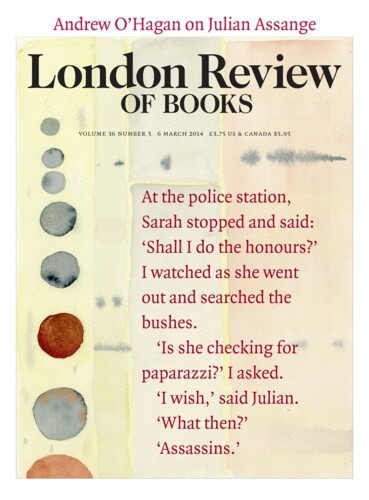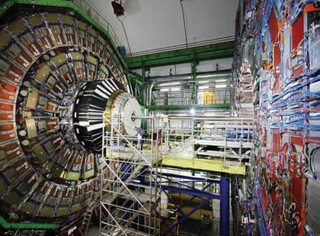The Large Hadron Collider at Cern is an extreme machine. As you go round the Science Museum’s new exhibition, Collider (until 5 May), you’re constantly reminded that it’s one of the biggest, fastest, coldest, deepest, most cleverly engineered and most expensive things ever made. It consists of two parallel hoop-shaped pipes, 27km long – almost as long as the Boulevard Périphérique round Paris – and buried 174m beneath the Franco-Swiss border. Beams of particles, most often protons, are injected into them, accelerated by magnets until they reach 99.9 per cent of the speed of light, and forced to cross so that the particles collide, smashing each other to pieces that the machine can then analyse. It took ten thousand scientists and engineers £5 billion and more than ten years to build. The magnets that line the machine, we’re told, are as long as the longest vehicles allowed on European roads. When it’s filled with particles its interior is chilled to -271°C, which is colder than deep space; but when the particles collide the points of contact are the hottest places on earth.
It’s not very portable, which must have made the exhibition difficult to curate. An accelerating cavity from the Large Electron-Positron Collider (LEP), the LHC’s slightly less extreme precursor, has been brought over from Cern. It looks like the bust of a copper robot from the golden age of sci-fi, with a bulbous round head, ribbed skin, red cyclopean eye and silver claws which project, raptor-style, from what would be its breast. A couple of the LHC’s spare parts are on show, but they’re less imposing. There’s something called a Transition Radiation Tracker wheel, which looks like a giant silver doughnut, and another thing called a Silicon Tracker Petal, which looks like the wing of a mechanical bird of prey, encrusted with mirrors and circuitry. These are beautiful objects, but they conceal more than they give away, the intricacies of their engineering obscured beneath inscrutable chrome.
They are components from two of the four ‘cathedral-sized’ detectors around the parallel pipes: it’s their job to collect data on the elementary particles released by collisions before they disappear – they decay almost as soon as they’re produced. The wheel and the wing-petal come from the Atlas (A Toroidal LHC Apparatus – toroidal is the technical term for doughnut-shaped) and CMS (Compact Muon Solenoid) experiments, which are designed to investigate such fundamentals as the origins of mass, the nature of the dark matter that makes up some 85 per cent of mass in the universe, and whether there are more dimensions than the four we know about. Other experiments have more specific purposes: Alice (A Large Ion Collider Experiment) is trying to create and detect quark-gluon plasma, a fluid blob of matter that hasn’t existed since the Big Bang.
Collider is more tell than show. You are invited to pretend that you’re an employee at Cern, or a distinguished visitor at least. As you arrive a voice says over the tannoy, ‘Welcome to Cern. Please take your seats in the lecture theatre. A closed meeting is about to begin,’ and the exhibition itself is done up to look like the Cern offices. There’s a pinboard with a notice on it for the Cern choral society; there’s almost as much on the Cern lifestyle as there is on the science. In the film you’re shown at the beginning, Cern scientists make jokes of a sort – ‘My wife says I care more about the proton beam than I do about her’ – and seem keen to assure us that they are just like regular people (they drink coffee, wear hoodies etc). As you walk round the show they pop up on screens and talk about their work. Hadrons are composite particles made up of various combinations of elementary particles called quarks and antiquarks: protons and neutrons are hadrons made up of three quarks; mesons are made up of one quark and one antiquark. The hadrons that get pumped into the LHC, the pop-up scientists explain, come whizzing out of bottles of hydrogen. As they flow down the pipes towards the collider they’re sped up by the Proton Synchrotron Booster. The powerful electromagnets in the walls of the collider make sure the particle beams stick to the sides.
One room is done up to look like a research scientist’s private quarters, complete with coffee cups, a DVD box-set of Star Wars movies and walls scrawled with A Beautiful Mind-style jottings. On a whiteboard there’s a drawing of a jigsaw puzzle, each piece marked with the name of a particle in the Standard Model, the best theory we have so far of how matter is composed and how its constituents interact. Some of them have beautiful names: muon, strange quark, charm quark. Others – the bottom quark – sound more Rabelaisian. Collider emphasises the richness of the language of particle physics: the moment when the LHC is stopped and the monitors checked for data is called the Unblinding.
Sixteen pieces of the jigsaw form a neat grid. The 17th piece is set slightly apart. The ‘Higgs boson’, named after one of the researchers who theorised its existence in the early 1960s, completes the Standard Model – without it we can’t explain why some particles have mass – and its discovery at Cern is the collider’s greatest achievement. The Standard Model had put the probability of a Higgs boson being produced in a particle collision at 1 in 10 billion, and the LEP had hunted it for more than a decade. On 4 July 2012 both Atlas and CMS independently announced the discovery of a particle with the mass of a Higgs, though of course they found it only by studying data from the detectors: the actual thing itself – and we’re still not completely sure it was the thing itself, though we’re getting surer – decayed in a tenth of a billion trillionth (10-²²) of a second.
One of the biggest things ever has found one of the smallest; the most sophisticated theory of particles we have has been confirmed by the toddler’s technique of pounding small things together and picking through the wreckage. This extravagant gap between means and ends comes close to instantiating a new form of sublime; at least, that’s how it feels as the tour deposits you back in front of the cyclopean android. ‘The most incomprehensible thing about the universe,’ Einstein once said, ‘is that it is comprehensible.’ That its most intimate secrets are made comprehensible by smashing them together in an enormous tube is almost unbelievable.
Send Letters To:
The Editor
London Review of Books,
28 Little Russell Street
London, WC1A 2HN
letters@lrb.co.uk
Please include name, address, and a telephone number.



